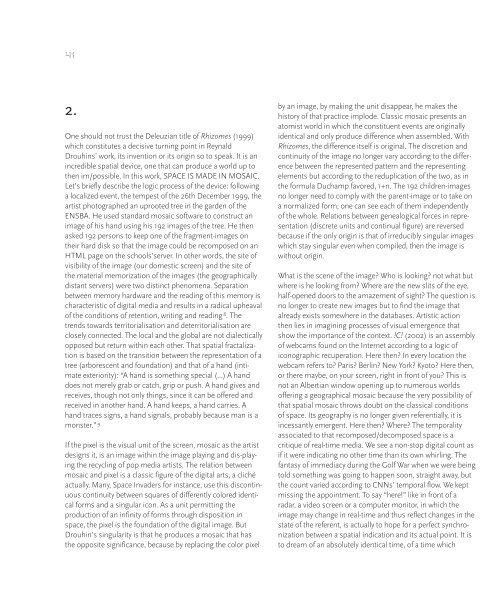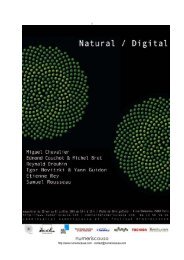Télécharger le pdf de la publication - Reynald Drouhin
Télécharger le pdf de la publication - Reynald Drouhin
Télécharger le pdf de la publication - Reynald Drouhin
You also want an ePaper? Increase the reach of your titles
YUMPU automatically turns print PDFs into web optimized ePapers that Google loves.
41<br />
2.<br />
One should not trust the De<strong>le</strong>uzian tit<strong>le</strong> of Rhizomes (1999)<br />
which constitutes a <strong>de</strong>cisive turning point in <strong>Reynald</strong><br />
<strong>Drouhin</strong>s’ work, its invention or its origin so to speak. It is an<br />
incredib<strong>le</strong> spatial <strong>de</strong>vice, one that can produce a world up to<br />
then im/possib<strong>le</strong>. In this work, SPACE IS MADE IN MOSAIC.<br />
Let’s briefly <strong>de</strong>scribe the logic process of the <strong>de</strong>vice: following<br />
a localized event, the tempest of the 26th December 1999, the<br />
artist photographed an uprooted tree in the gar<strong>de</strong>n of the<br />
ENSBA. He used standard mosaic software to construct an<br />
image of his hand using his 192 images of the tree. He then<br />
asked 192 persons to keep one of the fragment-images on<br />
their hard disk so that the image could be recomposed on an<br />
HTML page on the schools’server. In other words, the site of<br />
visibility of the image (our domestic screen) and the site of<br />
the material memorization of the images (the geographically<br />
distant servers) were two distinct phenomena. Separation<br />
between memory hardware and the reading of this memory is<br />
characteristic of digital media and results in a radical upheaval<br />
of the conditions of retention, writing and reading 8 . The<br />
trends towards territorialisation and <strong>de</strong>territorialisation are<br />
closely connected. The local and the global are not dia<strong>le</strong>ctically<br />
opposed but return within each other. That spatial fractalization<br />
is based on the transition between the representation of a<br />
tree (arborescent and foundation) and that of a hand (intimate<br />
exteriority): “A hand is something special (...) A hand<br />
does not merely grab or catch, grip or push. A hand gives and<br />
receives, though not only things, since it can be offered and<br />
received in another hand. A hand keeps, a hand carries. A<br />
hand traces signs, a hand signals, probably because man is a<br />
monster.” 9<br />
If the pixel is the visual unit of the screen, mosaic as the artist<br />
<strong>de</strong>signs it, is an image within the image p<strong>la</strong>ying and dis-p<strong>la</strong>ying<br />
the recycling of pop media artists. The re<strong>la</strong>tion between<br />
mosaic and pixel is a c<strong>la</strong>ssic figure of the digital arts, a cliché<br />
actually. Many, Space Inva<strong>de</strong>rs for instance, use this discontinuous<br />
continuity between squares of differently colored i<strong>de</strong>ntical<br />
forms and a singu<strong>la</strong>r icon. As a unit permitting the<br />
production of an infinity of forms through disposition in<br />
space, the pixel is the foundation of the digital image. But<br />
<strong>Drouhin</strong>’s singu<strong>la</strong>rity is that he produces a mosaic that has<br />
the opposite significance, because by rep<strong>la</strong>cing the color pixel<br />
by an image, by making the unit disappear, he makes the<br />
history of that practice implo<strong>de</strong>. C<strong>la</strong>ssic mosaic presents an<br />
atomist world in which the constituent events are originally<br />
i<strong>de</strong>ntical and only produce difference when assemb<strong>le</strong>d. With<br />
Rhizomes, the difference itself is original. The discretion and<br />
continuity of the image no longer vary according to the difference<br />
between the represented pattern and the representing<br />
e<strong>le</strong>ments but according to the reduplication of the two, as in<br />
the formu<strong>la</strong> Duchamp favored, 1+n. The 192 children-images<br />
no longer need to comply with the parent-image or to take on<br />
a normalized form; one can see each of them in<strong>de</strong>pen<strong>de</strong>ntly<br />
of the who<strong>le</strong>. Re<strong>la</strong>tions between genealogical forces in representation<br />
(discrete units and continual figure) are reversed<br />
because if the only origin is that of irreducibly singu<strong>la</strong>r images<br />
which stay singu<strong>la</strong>r even when compi<strong>le</strong>d, then the image is<br />
without origin.<br />
What is the scene of the image? Who is looking? not what but<br />
where is he looking from? Where are the new slits of the eye,<br />
half-opened doors to the amazement of sight? The question is<br />
no longer to create new images but to find the image that<br />
already exists somewhere in the databases. Artistic action<br />
then lies in imagining processes of visual emergence that<br />
show the importance of the context. !C! (2002) is an assembly<br />
of webcams found on the Internet according to a logic of<br />
iconographic recuperation. Here then? In every location the<br />
webcam refers to? Paris? Berlin? New York? Kyoto? Here then,<br />
or there maybe, on your screen, right in front of you? This is<br />
not an Albertian window opening up to numerous worlds<br />
offering a geographical mosaic because the very possibility of<br />
that spatial mosaic throws doubt on the c<strong>la</strong>ssical conditions<br />
of space. Its geography is no longer given referentially, it is<br />
incessantly emergent. Here then? Where? The temporality<br />
associated to that recomposed/<strong>de</strong>composed space is a<br />
critique of real-time media. We see a non-stop digital count as<br />
if it were indicating no other time than its own whirling. The<br />
fantasy of immediacy during the Golf War when we were being<br />
told something was going to happen soon, straight away, but<br />
the count varied according to CNNs’ temporal flow. We kept<br />
missing the appointment. To say “here!” like in front of a<br />
radar, a vi<strong>de</strong>o screen or a computer monitor, in which the<br />
image may change in real-time and thus ref<strong>le</strong>ct changes in the<br />
state of the referent, is actually to hope for a perfect synchronization<br />
between a spatial indication and its actual point. It is<br />
to dream of an absolutely i<strong>de</strong>ntical time, of a time which






